University Nursing Research: Evidence-Based Report Analysis
VerifiedAdded on 2020/05/11
|11
|3009
|222
Report
AI Summary
This report provides a critical analysis of a quantitative research article from the Australasian Emergency Nursing Journal, focusing on the impact of the emergency department triage environment on triage practices for clients with mental illness. The report examines the research methodology, including the ethnographic research design, sample and setting, and data collection methods. It assesses the trustworthiness of the research and evaluates the findings, which highlight the influence of the triage environment on assessment and client management. The analysis also discusses the relevance of the research to nursing practice, specifically in the context of a case scenario involving mental health clients in the emergency department. The report concludes by emphasizing the importance of creating secure and private triage environments to improve care for patients with mental illness and suggests areas for future research, such as analyzing the experiences of mental illness clients in the triage area.
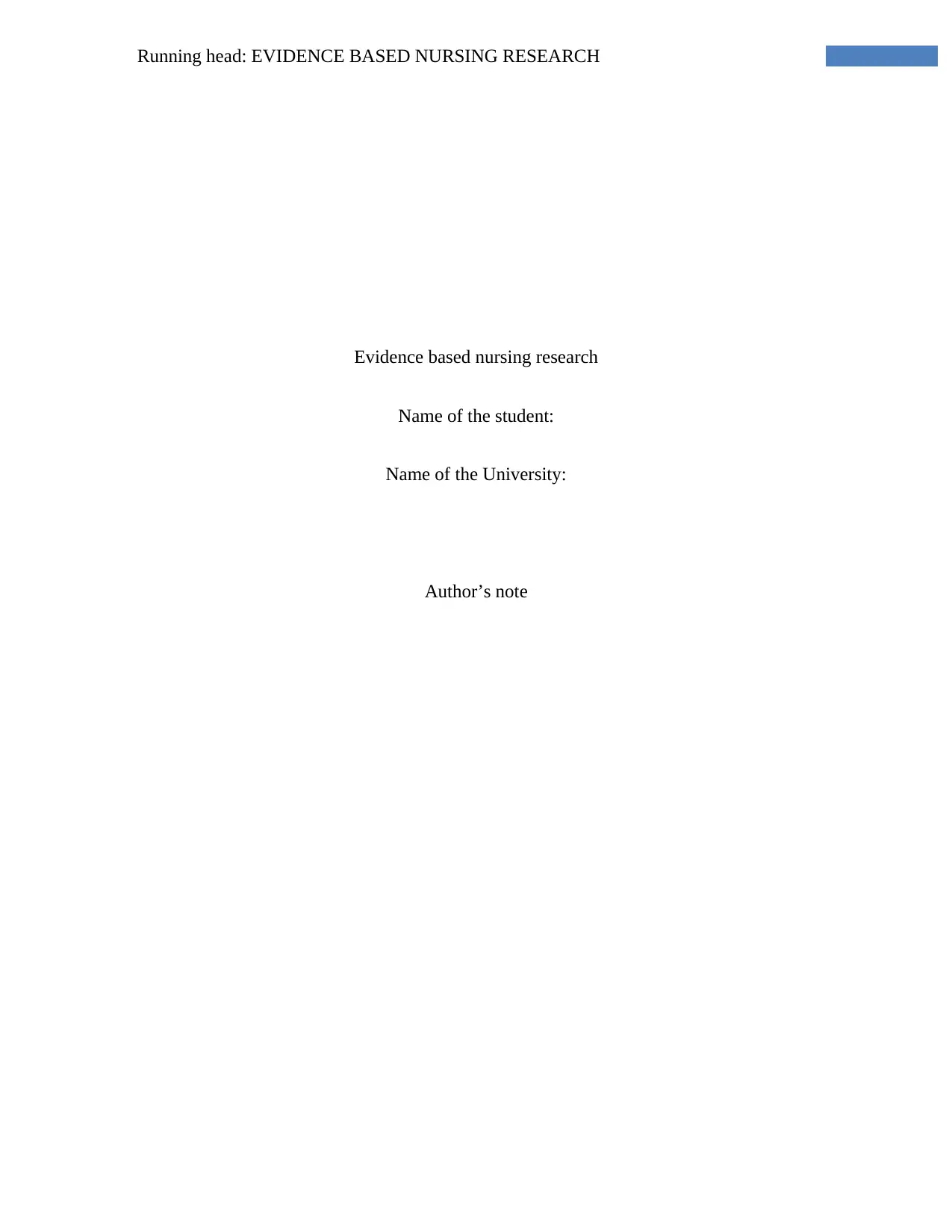
Running head: EVIDENCE BASED NURSING RESEARCH
Evidence based nursing research
Name of the student:
Name of the University:
Author’s note
Evidence based nursing research
Name of the student:
Name of the University:
Author’s note
Paraphrase This Document
Need a fresh take? Get an instant paraphrase of this document with our AI Paraphraser
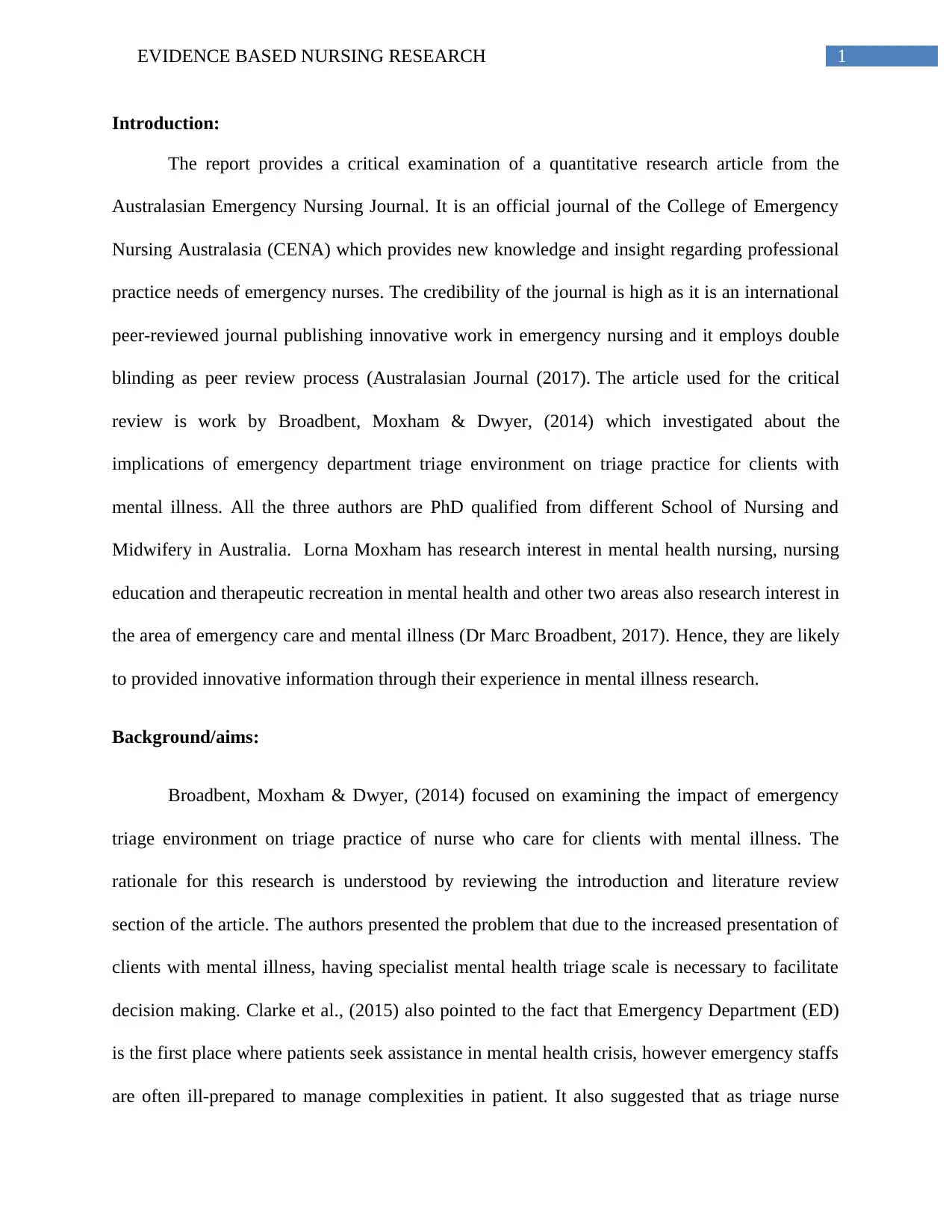
1EVIDENCE BASED NURSING RESEARCH
Introduction:
The report provides a critical examination of a quantitative research article from the
Australasian Emergency Nursing Journal. It is an official journal of the College of Emergency
Nursing Australasia (CENA) which provides new knowledge and insight regarding professional
practice needs of emergency nurses. The credibility of the journal is high as it is an international
peer-reviewed journal publishing innovative work in emergency nursing and it employs double
blinding as peer review process (Australasian Journal (2017). The article used for the critical
review is work by Broadbent, Moxham & Dwyer, (2014) which investigated about the
implications of emergency department triage environment on triage practice for clients with
mental illness. All the three authors are PhD qualified from different School of Nursing and
Midwifery in Australia. Lorna Moxham has research interest in mental health nursing, nursing
education and therapeutic recreation in mental health and other two areas also research interest in
the area of emergency care and mental illness (Dr Marc Broadbent, 2017). Hence, they are likely
to provided innovative information through their experience in mental illness research.
Background/aims:
Broadbent, Moxham & Dwyer, (2014) focused on examining the impact of emergency
triage environment on triage practice of nurse who care for clients with mental illness. The
rationale for this research is understood by reviewing the introduction and literature review
section of the article. The authors presented the problem that due to the increased presentation of
clients with mental illness, having specialist mental health triage scale is necessary to facilitate
decision making. Clarke et al., (2015) also pointed to the fact that Emergency Department (ED)
is the first place where patients seek assistance in mental health crisis, however emergency staffs
are often ill-prepared to manage complexities in patient. It also suggested that as triage nurse
Introduction:
The report provides a critical examination of a quantitative research article from the
Australasian Emergency Nursing Journal. It is an official journal of the College of Emergency
Nursing Australasia (CENA) which provides new knowledge and insight regarding professional
practice needs of emergency nurses. The credibility of the journal is high as it is an international
peer-reviewed journal publishing innovative work in emergency nursing and it employs double
blinding as peer review process (Australasian Journal (2017). The article used for the critical
review is work by Broadbent, Moxham & Dwyer, (2014) which investigated about the
implications of emergency department triage environment on triage practice for clients with
mental illness. All the three authors are PhD qualified from different School of Nursing and
Midwifery in Australia. Lorna Moxham has research interest in mental health nursing, nursing
education and therapeutic recreation in mental health and other two areas also research interest in
the area of emergency care and mental illness (Dr Marc Broadbent, 2017). Hence, they are likely
to provided innovative information through their experience in mental illness research.
Background/aims:
Broadbent, Moxham & Dwyer, (2014) focused on examining the impact of emergency
triage environment on triage practice of nurse who care for clients with mental illness. The
rationale for this research is understood by reviewing the introduction and literature review
section of the article. The authors presented the problem that due to the increased presentation of
clients with mental illness, having specialist mental health triage scale is necessary to facilitate
decision making. Clarke et al., (2015) also pointed to the fact that Emergency Department (ED)
is the first place where patients seek assistance in mental health crisis, however emergency staffs
are often ill-prepared to manage complexities in patient. It also suggested that as triage nurse
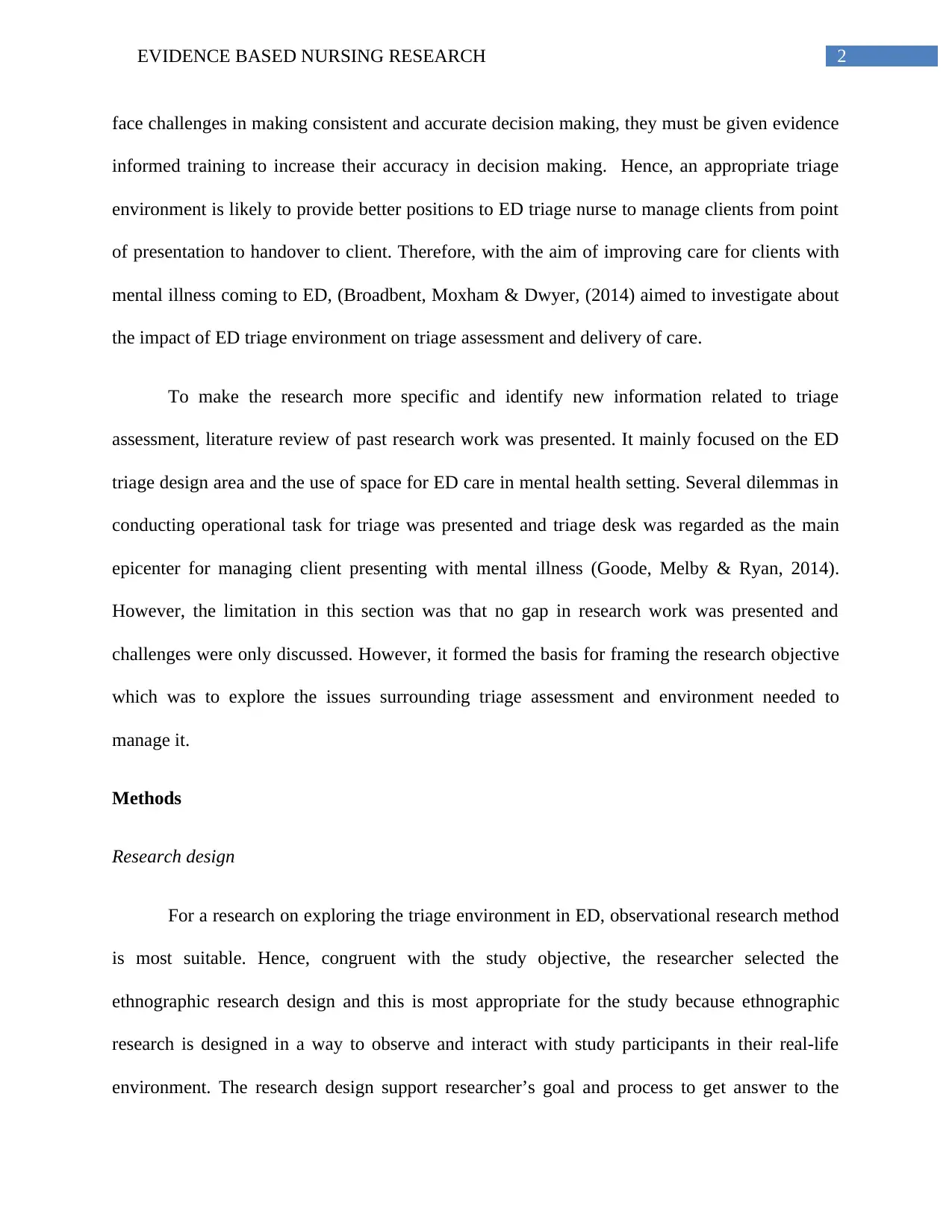
2EVIDENCE BASED NURSING RESEARCH
face challenges in making consistent and accurate decision making, they must be given evidence
informed training to increase their accuracy in decision making. Hence, an appropriate triage
environment is likely to provide better positions to ED triage nurse to manage clients from point
of presentation to handover to client. Therefore, with the aim of improving care for clients with
mental illness coming to ED, (Broadbent, Moxham & Dwyer, (2014) aimed to investigate about
the impact of ED triage environment on triage assessment and delivery of care.
To make the research more specific and identify new information related to triage
assessment, literature review of past research work was presented. It mainly focused on the ED
triage design area and the use of space for ED care in mental health setting. Several dilemmas in
conducting operational task for triage was presented and triage desk was regarded as the main
epicenter for managing client presenting with mental illness (Goode, Melby & Ryan, 2014).
However, the limitation in this section was that no gap in research work was presented and
challenges were only discussed. However, it formed the basis for framing the research objective
which was to explore the issues surrounding triage assessment and environment needed to
manage it.
Methods
Research design
For a research on exploring the triage environment in ED, observational research method
is most suitable. Hence, congruent with the study objective, the researcher selected the
ethnographic research design and this is most appropriate for the study because ethnographic
research is designed in a way to observe and interact with study participants in their real-life
environment. The research design support researcher’s goal and process to get answer to the
face challenges in making consistent and accurate decision making, they must be given evidence
informed training to increase their accuracy in decision making. Hence, an appropriate triage
environment is likely to provide better positions to ED triage nurse to manage clients from point
of presentation to handover to client. Therefore, with the aim of improving care for clients with
mental illness coming to ED, (Broadbent, Moxham & Dwyer, (2014) aimed to investigate about
the impact of ED triage environment on triage assessment and delivery of care.
To make the research more specific and identify new information related to triage
assessment, literature review of past research work was presented. It mainly focused on the ED
triage design area and the use of space for ED care in mental health setting. Several dilemmas in
conducting operational task for triage was presented and triage desk was regarded as the main
epicenter for managing client presenting with mental illness (Goode, Melby & Ryan, 2014).
However, the limitation in this section was that no gap in research work was presented and
challenges were only discussed. However, it formed the basis for framing the research objective
which was to explore the issues surrounding triage assessment and environment needed to
manage it.
Methods
Research design
For a research on exploring the triage environment in ED, observational research method
is most suitable. Hence, congruent with the study objective, the researcher selected the
ethnographic research design and this is most appropriate for the study because ethnographic
research is designed in a way to observe and interact with study participants in their real-life
environment. The research design support researcher’s goal and process to get answer to the
⊘ This is a preview!⊘
Do you want full access?
Subscribe today to unlock all pages.

Trusted by 1+ million students worldwide

3EVIDENCE BASED NURSING RESEARCH
research question. The use of ethnography improves data collection process because such design
also considers the cultural influence on clinical practice and reflexivity is possible with such
study design (Creswell & Poth, 2017). . As patients from diverse background come to ED for
mental illness treatment, Broadbent, Moxham & Dwyer, (2014) using ethnography is beneficial.
However, no time is spent with the participant because the article mainly explored one element
from the findings of a larger observational ethnographic study and that element include triage
practice environment and its effect on ED triage practice nurse.
Sample and setting
Broadbent, Moxham & Dwyer, (2014) explored one element from the findings of broader
observation ethnographic study and the research setting was a regional hospital in Australia with
a large emergency department and about 4.5% of clients came with mental health issues. The
main participants for the study included 45 qualified staff and one emergency nurse for morning
and night shift. Another two nurses were triage for the afternoon shift. Hence, it can be said that
the sample and setting has been described well by the researcher. However, the limitation is that
the hospital has only 4.5 patients presenting with mental illness and a greater flow of mentally ill
patient could have enhanced the validity of the study. Despite this, the sample size is appropriate
to get enough data, but the information regarding method used to recruit participants is missing.
In addition, study used more than two methods collecting data and purposive sampling technique
was used for conducting interview with triage nurse as they are likely to give realistic insight
about challenges in ED triage assessment.
Data collection
research question. The use of ethnography improves data collection process because such design
also considers the cultural influence on clinical practice and reflexivity is possible with such
study design (Creswell & Poth, 2017). . As patients from diverse background come to ED for
mental illness treatment, Broadbent, Moxham & Dwyer, (2014) using ethnography is beneficial.
However, no time is spent with the participant because the article mainly explored one element
from the findings of a larger observational ethnographic study and that element include triage
practice environment and its effect on ED triage practice nurse.
Sample and setting
Broadbent, Moxham & Dwyer, (2014) explored one element from the findings of broader
observation ethnographic study and the research setting was a regional hospital in Australia with
a large emergency department and about 4.5% of clients came with mental health issues. The
main participants for the study included 45 qualified staff and one emergency nurse for morning
and night shift. Another two nurses were triage for the afternoon shift. Hence, it can be said that
the sample and setting has been described well by the researcher. However, the limitation is that
the hospital has only 4.5 patients presenting with mental illness and a greater flow of mentally ill
patient could have enhanced the validity of the study. Despite this, the sample size is appropriate
to get enough data, but the information regarding method used to recruit participants is missing.
In addition, study used more than two methods collecting data and purposive sampling technique
was used for conducting interview with triage nurse as they are likely to give realistic insight
about challenges in ED triage assessment.
Data collection
Paraphrase This Document
Need a fresh take? Get an instant paraphrase of this document with our AI Paraphraser
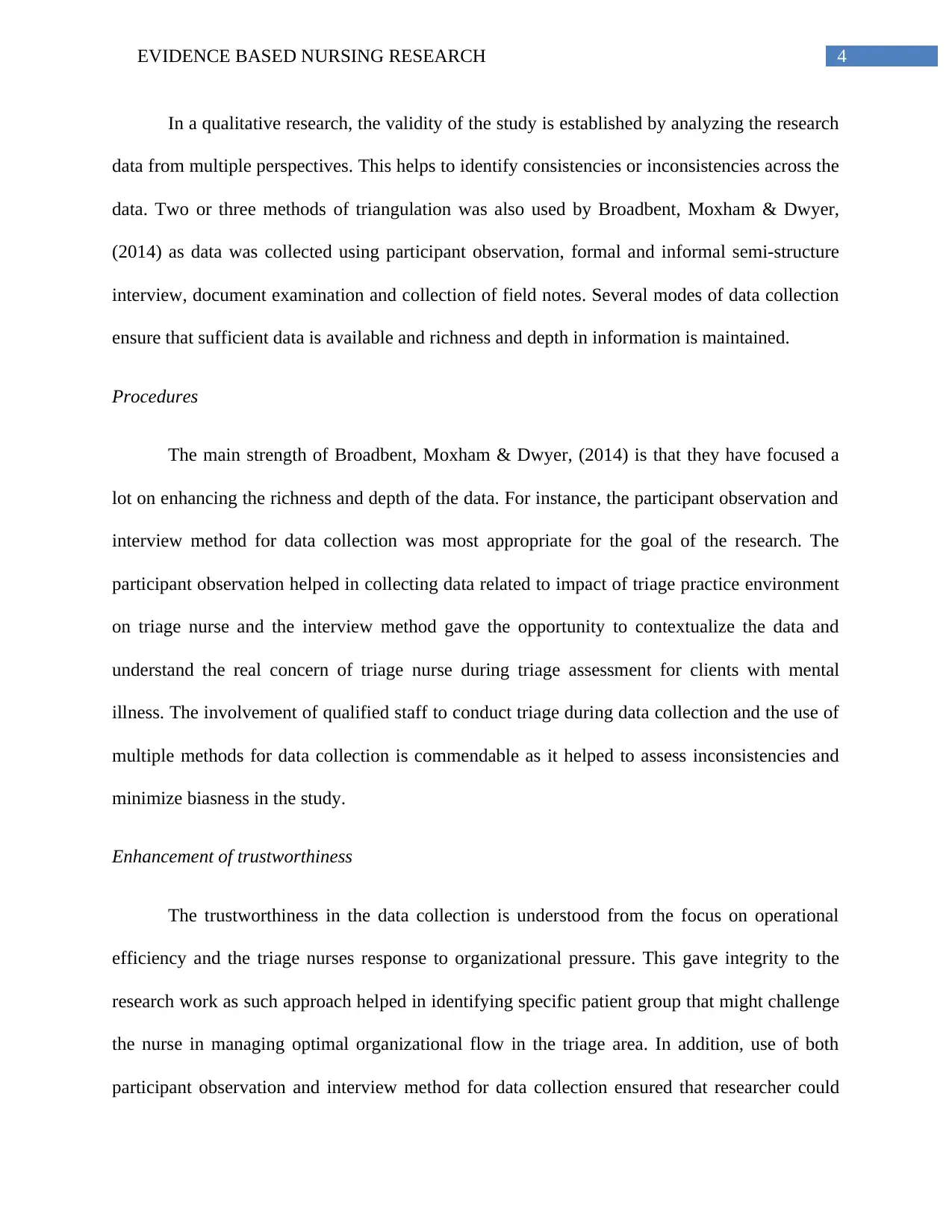
4EVIDENCE BASED NURSING RESEARCH
In a qualitative research, the validity of the study is established by analyzing the research
data from multiple perspectives. This helps to identify consistencies or inconsistencies across the
data. Two or three methods of triangulation was also used by Broadbent, Moxham & Dwyer,
(2014) as data was collected using participant observation, formal and informal semi-structure
interview, document examination and collection of field notes. Several modes of data collection
ensure that sufficient data is available and richness and depth in information is maintained.
Procedures
The main strength of Broadbent, Moxham & Dwyer, (2014) is that they have focused a
lot on enhancing the richness and depth of the data. For instance, the participant observation and
interview method for data collection was most appropriate for the goal of the research. The
participant observation helped in collecting data related to impact of triage practice environment
on triage nurse and the interview method gave the opportunity to contextualize the data and
understand the real concern of triage nurse during triage assessment for clients with mental
illness. The involvement of qualified staff to conduct triage during data collection and the use of
multiple methods for data collection is commendable as it helped to assess inconsistencies and
minimize biasness in the study.
Enhancement of trustworthiness
The trustworthiness in the data collection is understood from the focus on operational
efficiency and the triage nurses response to organizational pressure. This gave integrity to the
research work as such approach helped in identifying specific patient group that might challenge
the nurse in managing optimal organizational flow in the triage area. In addition, use of both
participant observation and interview method for data collection ensured that researcher could
In a qualitative research, the validity of the study is established by analyzing the research
data from multiple perspectives. This helps to identify consistencies or inconsistencies across the
data. Two or three methods of triangulation was also used by Broadbent, Moxham & Dwyer,
(2014) as data was collected using participant observation, formal and informal semi-structure
interview, document examination and collection of field notes. Several modes of data collection
ensure that sufficient data is available and richness and depth in information is maintained.
Procedures
The main strength of Broadbent, Moxham & Dwyer, (2014) is that they have focused a
lot on enhancing the richness and depth of the data. For instance, the participant observation and
interview method for data collection was most appropriate for the goal of the research. The
participant observation helped in collecting data related to impact of triage practice environment
on triage nurse and the interview method gave the opportunity to contextualize the data and
understand the real concern of triage nurse during triage assessment for clients with mental
illness. The involvement of qualified staff to conduct triage during data collection and the use of
multiple methods for data collection is commendable as it helped to assess inconsistencies and
minimize biasness in the study.
Enhancement of trustworthiness
The trustworthiness in the data collection is understood from the focus on operational
efficiency and the triage nurses response to organizational pressure. This gave integrity to the
research work as such approach helped in identifying specific patient group that might challenge
the nurse in managing optimal organizational flow in the triage area. In addition, use of both
participant observation and interview method for data collection ensured that researcher could
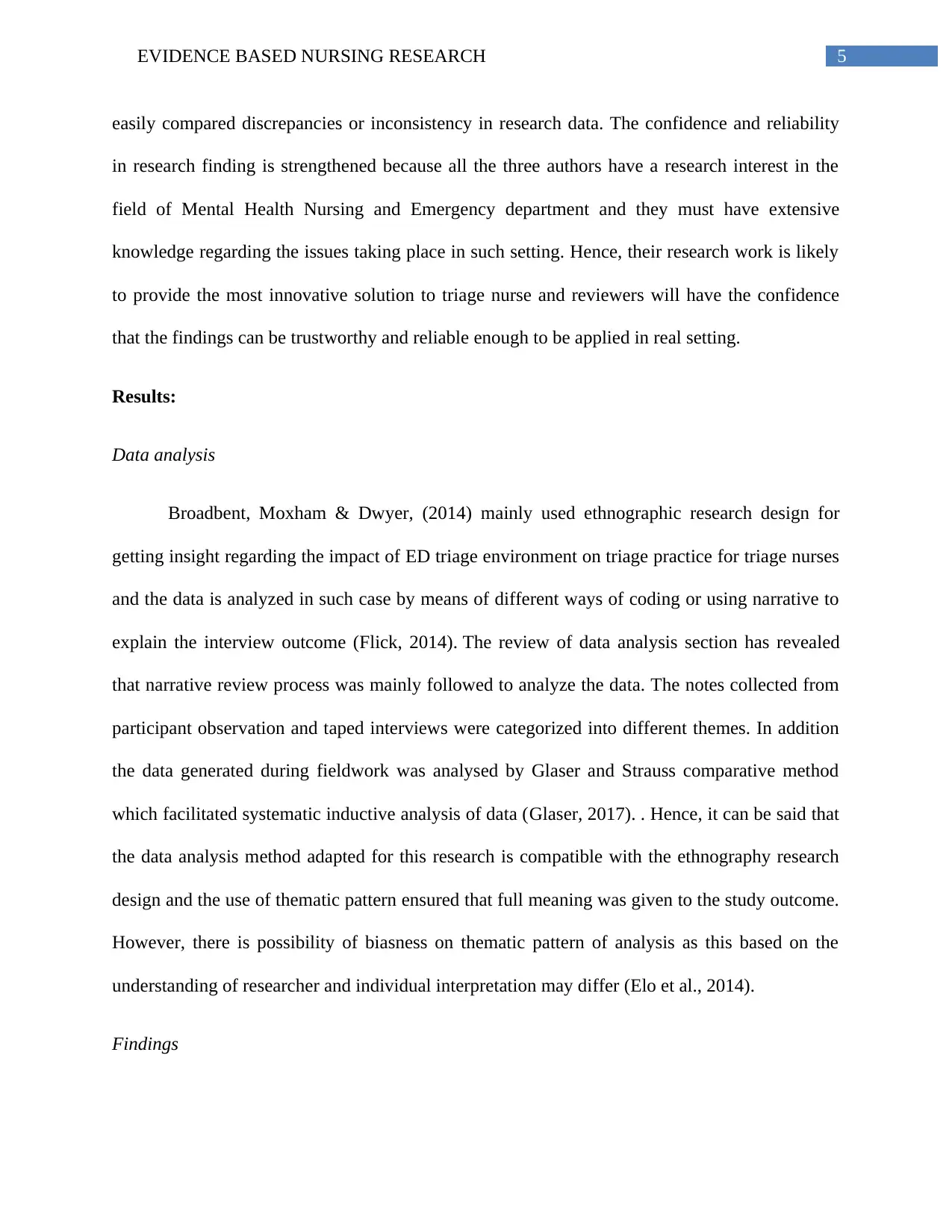
5EVIDENCE BASED NURSING RESEARCH
easily compared discrepancies or inconsistency in research data. The confidence and reliability
in research finding is strengthened because all the three authors have a research interest in the
field of Mental Health Nursing and Emergency department and they must have extensive
knowledge regarding the issues taking place in such setting. Hence, their research work is likely
to provide the most innovative solution to triage nurse and reviewers will have the confidence
that the findings can be trustworthy and reliable enough to be applied in real setting.
Results:
Data analysis
Broadbent, Moxham & Dwyer, (2014) mainly used ethnographic research design for
getting insight regarding the impact of ED triage environment on triage practice for triage nurses
and the data is analyzed in such case by means of different ways of coding or using narrative to
explain the interview outcome (Flick, 2014). The review of data analysis section has revealed
that narrative review process was mainly followed to analyze the data. The notes collected from
participant observation and taped interviews were categorized into different themes. In addition
the data generated during fieldwork was analysed by Glaser and Strauss comparative method
which facilitated systematic inductive analysis of data (Glaser, 2017). . Hence, it can be said that
the data analysis method adapted for this research is compatible with the ethnography research
design and the use of thematic pattern ensured that full meaning was given to the study outcome.
However, there is possibility of biasness on thematic pattern of analysis as this based on the
understanding of researcher and individual interpretation may differ (Elo et al., 2014).
Findings
easily compared discrepancies or inconsistency in research data. The confidence and reliability
in research finding is strengthened because all the three authors have a research interest in the
field of Mental Health Nursing and Emergency department and they must have extensive
knowledge regarding the issues taking place in such setting. Hence, their research work is likely
to provide the most innovative solution to triage nurse and reviewers will have the confidence
that the findings can be trustworthy and reliable enough to be applied in real setting.
Results:
Data analysis
Broadbent, Moxham & Dwyer, (2014) mainly used ethnographic research design for
getting insight regarding the impact of ED triage environment on triage practice for triage nurses
and the data is analyzed in such case by means of different ways of coding or using narrative to
explain the interview outcome (Flick, 2014). The review of data analysis section has revealed
that narrative review process was mainly followed to analyze the data. The notes collected from
participant observation and taped interviews were categorized into different themes. In addition
the data generated during fieldwork was analysed by Glaser and Strauss comparative method
which facilitated systematic inductive analysis of data (Glaser, 2017). . Hence, it can be said that
the data analysis method adapted for this research is compatible with the ethnography research
design and the use of thematic pattern ensured that full meaning was given to the study outcome.
However, there is possibility of biasness on thematic pattern of analysis as this based on the
understanding of researcher and individual interpretation may differ (Elo et al., 2014).
Findings
⊘ This is a preview!⊘
Do you want full access?
Subscribe today to unlock all pages.

Trusted by 1+ million students worldwide
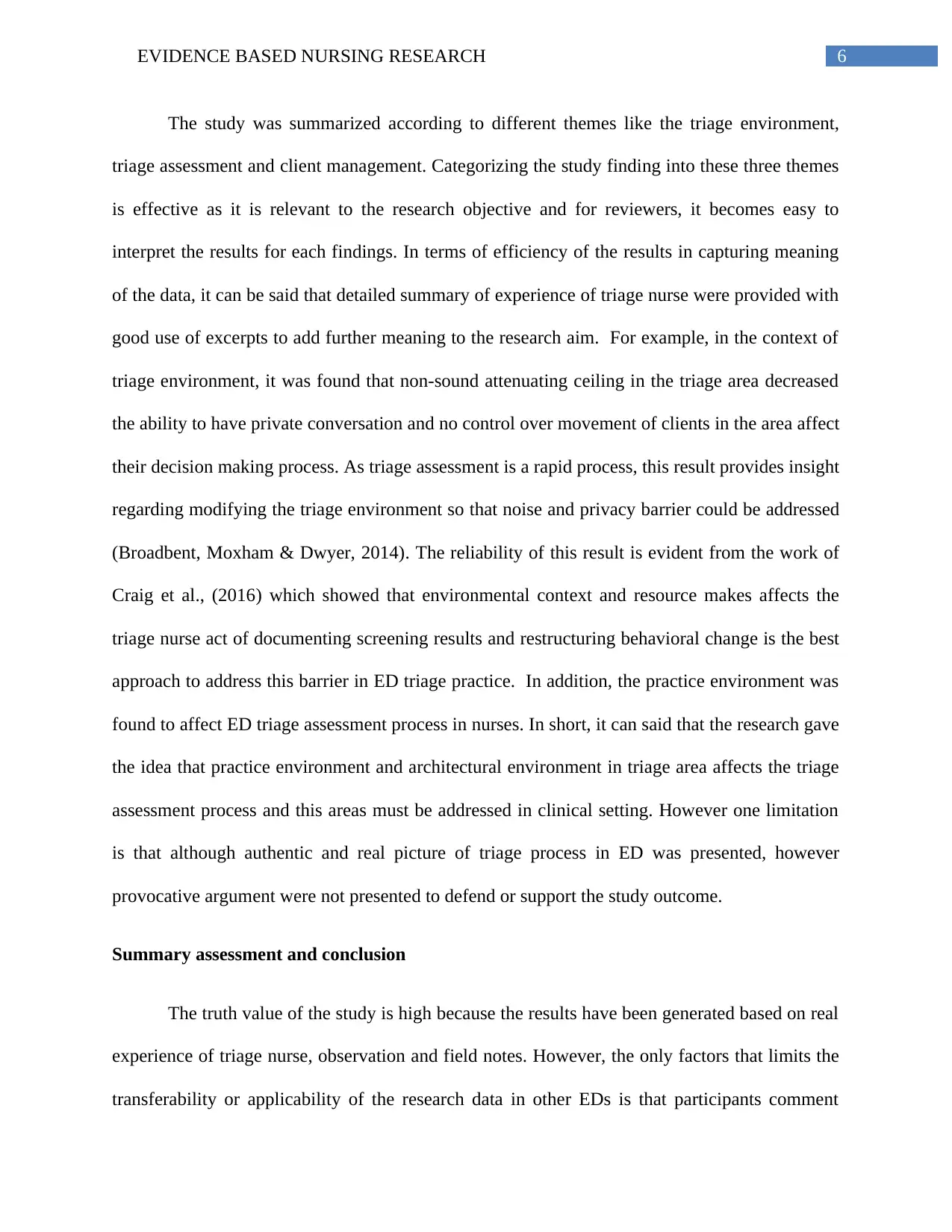
6EVIDENCE BASED NURSING RESEARCH
The study was summarized according to different themes like the triage environment,
triage assessment and client management. Categorizing the study finding into these three themes
is effective as it is relevant to the research objective and for reviewers, it becomes easy to
interpret the results for each findings. In terms of efficiency of the results in capturing meaning
of the data, it can be said that detailed summary of experience of triage nurse were provided with
good use of excerpts to add further meaning to the research aim. For example, in the context of
triage environment, it was found that non-sound attenuating ceiling in the triage area decreased
the ability to have private conversation and no control over movement of clients in the area affect
their decision making process. As triage assessment is a rapid process, this result provides insight
regarding modifying the triage environment so that noise and privacy barrier could be addressed
(Broadbent, Moxham & Dwyer, 2014). The reliability of this result is evident from the work of
Craig et al., (2016) which showed that environmental context and resource makes affects the
triage nurse act of documenting screening results and restructuring behavioral change is the best
approach to address this barrier in ED triage practice. In addition, the practice environment was
found to affect ED triage assessment process in nurses. In short, it can said that the research gave
the idea that practice environment and architectural environment in triage area affects the triage
assessment process and this areas must be addressed in clinical setting. However one limitation
is that although authentic and real picture of triage process in ED was presented, however
provocative argument were not presented to defend or support the study outcome.
Summary assessment and conclusion
The truth value of the study is high because the results have been generated based on real
experience of triage nurse, observation and field notes. However, the only factors that limits the
transferability or applicability of the research data in other EDs is that participants comment
The study was summarized according to different themes like the triage environment,
triage assessment and client management. Categorizing the study finding into these three themes
is effective as it is relevant to the research objective and for reviewers, it becomes easy to
interpret the results for each findings. In terms of efficiency of the results in capturing meaning
of the data, it can be said that detailed summary of experience of triage nurse were provided with
good use of excerpts to add further meaning to the research aim. For example, in the context of
triage environment, it was found that non-sound attenuating ceiling in the triage area decreased
the ability to have private conversation and no control over movement of clients in the area affect
their decision making process. As triage assessment is a rapid process, this result provides insight
regarding modifying the triage environment so that noise and privacy barrier could be addressed
(Broadbent, Moxham & Dwyer, 2014). The reliability of this result is evident from the work of
Craig et al., (2016) which showed that environmental context and resource makes affects the
triage nurse act of documenting screening results and restructuring behavioral change is the best
approach to address this barrier in ED triage practice. In addition, the practice environment was
found to affect ED triage assessment process in nurses. In short, it can said that the research gave
the idea that practice environment and architectural environment in triage area affects the triage
assessment process and this areas must be addressed in clinical setting. However one limitation
is that although authentic and real picture of triage process in ED was presented, however
provocative argument were not presented to defend or support the study outcome.
Summary assessment and conclusion
The truth value of the study is high because the results have been generated based on real
experience of triage nurse, observation and field notes. However, the only factors that limits the
transferability or applicability of the research data in other EDs is that participants comment
Paraphrase This Document
Need a fresh take? Get an instant paraphrase of this document with our AI Paraphraser

7EVIDENCE BASED NURSING RESEARCH
reflected social, cultural and historical context behind challenges in triage assessment and this
may differ across different setting. Despite this, it informs areas of change in triage environment
and triage practice for ED triage nurse. The research mainly pointed out to the provision of
building secure and private environment for triage nurses and gives triage nurse enough space to
interact and deal with mental health clients. This can be a systematic approach to address barrier
in complex care environment Craig et al., (2017). This is meaningful evidence that can be
applied to build a triage area, however as the focus is on triage assessment for mental illness
client, future research should also focus on analyzing the experience of mental illness client in
triage area.
Relevance to nursing practice and case scenario
The article by Broadbent, Moxham & Dwyer, (2014) was mainly reviewed to solve the
personal problem faced according to the case scenario. The case scenario is related to the
problem that people with mental illness mainly use ED as the first point of access to care,
however the ED does not have MH clinician to rostered in ED to handle such patients. In this
scenario, the main problem was related to the safety and privacy of client with mental illness
presenting to the ED. In this context, the work by Broadbent, Moxham & Dwyer, (2014) is
considered most appropriate to solve the problem as it mainly gives the idea that there should be
triage nurse in the ED specifically for clients with mental illness. The main implication of the
result for the nursing practice was that it gave the idea that appropriate triage environment is the
solution to both safety and privacy issues of client. The focus on triage area free from noise and
movement barrier is likely to enhance patient values because triage nurse can closely
communicate with patient and their clinical expertise in dealing with such client will also be
enhanced as private space will increase their concentration and enhance decision making and
reflected social, cultural and historical context behind challenges in triage assessment and this
may differ across different setting. Despite this, it informs areas of change in triage environment
and triage practice for ED triage nurse. The research mainly pointed out to the provision of
building secure and private environment for triage nurses and gives triage nurse enough space to
interact and deal with mental health clients. This can be a systematic approach to address barrier
in complex care environment Craig et al., (2017). This is meaningful evidence that can be
applied to build a triage area, however as the focus is on triage assessment for mental illness
client, future research should also focus on analyzing the experience of mental illness client in
triage area.
Relevance to nursing practice and case scenario
The article by Broadbent, Moxham & Dwyer, (2014) was mainly reviewed to solve the
personal problem faced according to the case scenario. The case scenario is related to the
problem that people with mental illness mainly use ED as the first point of access to care,
however the ED does not have MH clinician to rostered in ED to handle such patients. In this
scenario, the main problem was related to the safety and privacy of client with mental illness
presenting to the ED. In this context, the work by Broadbent, Moxham & Dwyer, (2014) is
considered most appropriate to solve the problem as it mainly gives the idea that there should be
triage nurse in the ED specifically for clients with mental illness. The main implication of the
result for the nursing practice was that it gave the idea that appropriate triage environment is the
solution to both safety and privacy issues of client. The focus on triage area free from noise and
movement barrier is likely to enhance patient values because triage nurse can closely
communicate with patient and their clinical expertise in dealing with such client will also be
enhanced as private space will increase their concentration and enhance decision making and

8EVIDENCE BASED NURSING RESEARCH
screening procedures (Martin & Eckert, 2016). However, the study results cannot be used to
inform evidence based practice in the case scenario because it has not investigated about
experience of patient and triage nurse were only the main participants for the study. Future
research work with client’s experience in triage area is likely to provide holistic solution to
enhance ED triage assessment. Despite this, the challenges of triage nurse and impact of
environment of triage practice for nurses is supported by many other research work (Craig et al.,
2017).
screening procedures (Martin & Eckert, 2016). However, the study results cannot be used to
inform evidence based practice in the case scenario because it has not investigated about
experience of patient and triage nurse were only the main participants for the study. Future
research work with client’s experience in triage area is likely to provide holistic solution to
enhance ED triage assessment. Despite this, the challenges of triage nurse and impact of
environment of triage practice for nurses is supported by many other research work (Craig et al.,
2017).
⊘ This is a preview!⊘
Do you want full access?
Subscribe today to unlock all pages.

Trusted by 1+ million students worldwide
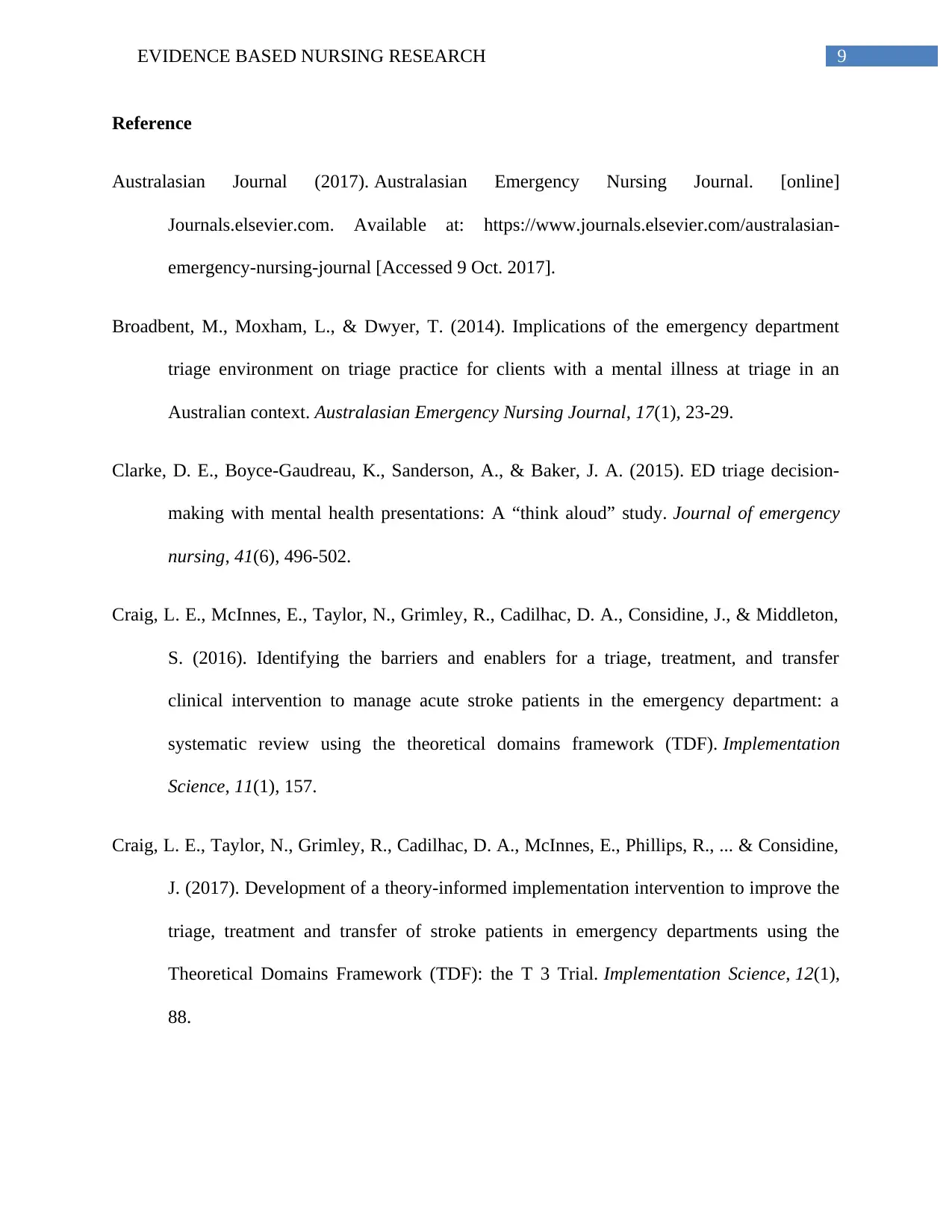
9EVIDENCE BASED NURSING RESEARCH
Reference
Australasian Journal (2017). Australasian Emergency Nursing Journal. [online]
Journals.elsevier.com. Available at: https://www.journals.elsevier.com/australasian-
emergency-nursing-journal [Accessed 9 Oct. 2017].
Broadbent, M., Moxham, L., & Dwyer, T. (2014). Implications of the emergency department
triage environment on triage practice for clients with a mental illness at triage in an
Australian context. Australasian Emergency Nursing Journal, 17(1), 23-29.
Clarke, D. E., Boyce-Gaudreau, K., Sanderson, A., & Baker, J. A. (2015). ED triage decision-
making with mental health presentations: A “think aloud” study. Journal of emergency
nursing, 41(6), 496-502.
Craig, L. E., McInnes, E., Taylor, N., Grimley, R., Cadilhac, D. A., Considine, J., & Middleton,
S. (2016). Identifying the barriers and enablers for a triage, treatment, and transfer
clinical intervention to manage acute stroke patients in the emergency department: a
systematic review using the theoretical domains framework (TDF). Implementation
Science, 11(1), 157.
Craig, L. E., Taylor, N., Grimley, R., Cadilhac, D. A., McInnes, E., Phillips, R., ... & Considine,
J. (2017). Development of a theory-informed implementation intervention to improve the
triage, treatment and transfer of stroke patients in emergency departments using the
Theoretical Domains Framework (TDF): the T 3 Trial. Implementation Science, 12(1),
88.
Reference
Australasian Journal (2017). Australasian Emergency Nursing Journal. [online]
Journals.elsevier.com. Available at: https://www.journals.elsevier.com/australasian-
emergency-nursing-journal [Accessed 9 Oct. 2017].
Broadbent, M., Moxham, L., & Dwyer, T. (2014). Implications of the emergency department
triage environment on triage practice for clients with a mental illness at triage in an
Australian context. Australasian Emergency Nursing Journal, 17(1), 23-29.
Clarke, D. E., Boyce-Gaudreau, K., Sanderson, A., & Baker, J. A. (2015). ED triage decision-
making with mental health presentations: A “think aloud” study. Journal of emergency
nursing, 41(6), 496-502.
Craig, L. E., McInnes, E., Taylor, N., Grimley, R., Cadilhac, D. A., Considine, J., & Middleton,
S. (2016). Identifying the barriers and enablers for a triage, treatment, and transfer
clinical intervention to manage acute stroke patients in the emergency department: a
systematic review using the theoretical domains framework (TDF). Implementation
Science, 11(1), 157.
Craig, L. E., Taylor, N., Grimley, R., Cadilhac, D. A., McInnes, E., Phillips, R., ... & Considine,
J. (2017). Development of a theory-informed implementation intervention to improve the
triage, treatment and transfer of stroke patients in emergency departments using the
Theoretical Domains Framework (TDF): the T 3 Trial. Implementation Science, 12(1),
88.
Paraphrase This Document
Need a fresh take? Get an instant paraphrase of this document with our AI Paraphraser

10EVIDENCE BASED NURSING RESEARCH
Craig, L.E., Churilov, L., Olenko, L., Cadilhac, D.A., Grimley, R., Dale, S., Martinez-Garduno,
C., McInnes, E., Considine, J., Grimshaw, J.M. and Middleton, S., 2017. Testing a
systematic approach to identify and prioritise barriers to successful implementation of a
complex healthcare intervention. BMC medical research methodology, 17(1), p.24.
Creswell, J. W., & Poth, C. N. (2017). Qualitative inquiry and research design: Choosing among
five approaches. Sage publications.
Dr Marc Broadbent. (2017). Usc.edu.au. [online] Available at:
http://www.usc.edu.au/explore/structure/faculty-of-science-health-education-and-
engineering/staff/dr-marc-broadbent [Accessed 9 Oct. 2017].
Elo, S., Kääriäinen, M., Kanste, O., Pölkki, T., Utriainen, K., & Kyngäs, H. (2014). Qualitative
content analysis: A focus on trustworthiness. Sage Open, 4(1), 2158244014522633.
Flick, U. (2014). An introduction to qualitative research. Sage.
Glaser, B. (2017). Discovery of grounded theory: Strategies for qualitative research. Routledge.
Goode, D., Melby, V., & Ryan, A. (2014). Management of patients with mental health needs:
Debbie Goode and colleagues assess whether staff are prepared to offer person-centred
care to all people who present to emergency departments. Emergency Nurse, 22(5), 32-
37.
Martin, M. J., & Eckert, M. J. (2016). Difficult Triage Decisions in the Combat or Austere
Environment. In Surgery During Natural Disasters, Combat, Terrorist Attacks, and
Crisis Situations (pp. 47-55). Springer International Publishing.
Craig, L.E., Churilov, L., Olenko, L., Cadilhac, D.A., Grimley, R., Dale, S., Martinez-Garduno,
C., McInnes, E., Considine, J., Grimshaw, J.M. and Middleton, S., 2017. Testing a
systematic approach to identify and prioritise barriers to successful implementation of a
complex healthcare intervention. BMC medical research methodology, 17(1), p.24.
Creswell, J. W., & Poth, C. N. (2017). Qualitative inquiry and research design: Choosing among
five approaches. Sage publications.
Dr Marc Broadbent. (2017). Usc.edu.au. [online] Available at:
http://www.usc.edu.au/explore/structure/faculty-of-science-health-education-and-
engineering/staff/dr-marc-broadbent [Accessed 9 Oct. 2017].
Elo, S., Kääriäinen, M., Kanste, O., Pölkki, T., Utriainen, K., & Kyngäs, H. (2014). Qualitative
content analysis: A focus on trustworthiness. Sage Open, 4(1), 2158244014522633.
Flick, U. (2014). An introduction to qualitative research. Sage.
Glaser, B. (2017). Discovery of grounded theory: Strategies for qualitative research. Routledge.
Goode, D., Melby, V., & Ryan, A. (2014). Management of patients with mental health needs:
Debbie Goode and colleagues assess whether staff are prepared to offer person-centred
care to all people who present to emergency departments. Emergency Nurse, 22(5), 32-
37.
Martin, M. J., & Eckert, M. J. (2016). Difficult Triage Decisions in the Combat or Austere
Environment. In Surgery During Natural Disasters, Combat, Terrorist Attacks, and
Crisis Situations (pp. 47-55). Springer International Publishing.
1 out of 11
Related Documents
Your All-in-One AI-Powered Toolkit for Academic Success.
+13062052269
info@desklib.com
Available 24*7 on WhatsApp / Email
![[object Object]](/_next/static/media/star-bottom.7253800d.svg)
Unlock your academic potential
Copyright © 2020–2025 A2Z Services. All Rights Reserved. Developed and managed by ZUCOL.





